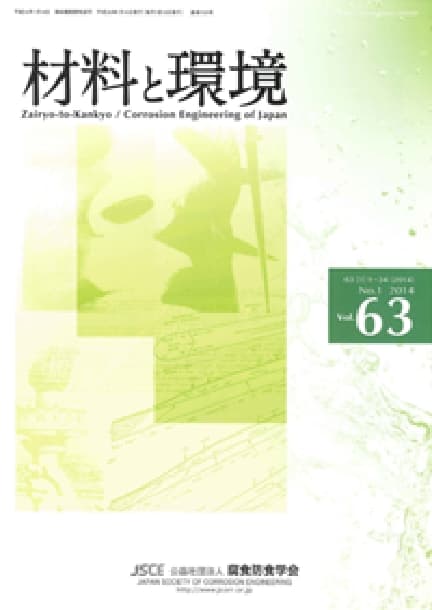- TOP
- Zairyo-to-Kankyo
- Vol. 58 (2009), No. 7
Zairyo-to-Kankyo Vol. 58 (2009), No. 7
Backnumber
-
Vol. 74 (2025)
-
Vol. 73 (2024)
-
Vol. 72 (2023)
-
Vol. 71 (2022)
-
Vol. 70 (2021)
-
Vol. 69 (2020)
-
Vol. 68 (2019)
-
Vol. 67 (2018)
-
Vol. 66 (2017)
-
Vol. 65 (2016)
-
Vol. 64 (2015)
-
Vol. 63 (2014)
-
Vol. 62 (2013)
-
Vol. 61 (2012)
-
Vol. 60 (2011)
-
Vol. 59 (2010)
-
Vol. 58 (2009)
-
Vol. 57 (2008)
-
Vol. 56 (2007)
-
Vol. 55 (2006)
-
Vol. 54 (2005)
-
Vol. 53 (2004)
-
Vol. 52 (2003)
-
Vol. 51 (2002)
-
Vol. 50 (2001)
-
Vol. 49 (2000)
-
Vol. 48 (1999)
-
Vol. 47 (1998)
-
Vol. 46 (1997)
-
Vol. 45 (1996)
-
Vol. 44 (1995)
-
Vol. 43 (1994)
-
Vol. 42 (1993)
-
Vol. 41 (1992)
-
Vol. 40 (1991)
Keyword Ranking
14 Dec. (Last 30 Days)
Zairyo-to-Kankyo Vol. 58 (2009), No. 7
Global Carbon Dioxide Recycling
Koji Hashimoto, Naokazu Kumagai, Zenta Kato, Koichi Izumiya
pp. 250-259
DOI:
10.3323/jcorr.58.250Abstract
Extrapolation of world energy consumption between 1990 and 2006 to the future reveals the complete exhaustion of petroleum, natural gas, coal and uranium reserves on the Earth in 2037, 2042, 2055 and 2057, respectively. We are proposing global carbon dioxide recycling to use renewable energy by which all people in the whole world can survive. The electricity will be generated by solar cell in the deserts and used for production of hydrogen by seawater electrolysis at the nearby desert coasts. Hydrogen, for which no infrastructures of transportation and combustion exist, will be converted to methane at the desert coasts by the reaction with carbon dioxide captured by energy consumers. Among systems in global carbon dioxide recycling, seawater electrolysis and carbon dioxide methanation have not been performed industrially. We created energy-saving cathodes for hydrogen production and anodes for oxygen evolution without chlorine formation in seawater electrolysis, and ideal catalysts for methane formation by the reaction of carbon dioxide with hydrogen. The key factors for realization of global carbon dioxide recycling are the activity enhancement and corrosion prevention of those key materials.
Electrochemical Measurement of Hydrogen Accumulated in a Steel during Wet and Dry Cyclic Conditions
Atsushi Komatsu, Atsushi Nishikata, Tooru Tsuru
pp. 269-273
DOI:
10.3323/jcorr.58.269Abstract
Hydrogen accumulated in eutectoid steels with different heat treatments was measured using electrochemical method. This method pulled out about 30% lesser amount of hydrogen than that determined by thermal desorption method. Hydrogen content in steels accumulated during single corrosion cycle was about 0.01 to 0.1 ppm and they depended on microstructure of steels. Hydrogen content in different microstructure of steels decreased in the order of: Martensite > pearlite > spheroidized cementite-ferrite. The amount of hydrogen accumulated during several continuous corrosion cycles was larger than that observed in single cycle, and the difference of hydrogen content between microstructures became also lager.
Corrosion Film Formation on Carbon Steels in Bicarbonate Solutions
Toshio Shibata, Yoshiaki Shimizu
pp. 274-279
DOI:
10.3323/jcorr.58.274Abstract
In order to understand the detailed corrosion process of carbon steel depending on pH in the neutral solution, corrosion film formation reaction on the steel surface in 0.01M NaHCO3 solution has been analyzed as a function of pH, the value of which was adjusted by bubbling a mixture of air and CO2 gas at an atmospheric pressure. It was found that precipitation ratio defined as the amount of precipitated film to the total corrosion loss increases with increase of pH, resulting in decrease of the total corrosion loss with increasing pH in the range between pH=3.5 and 10. Small addition of alloying elements such as Cu and Ni was also found to change the precipitation ratio. The film formation reaction is rationally explained by assuming that precipitation is decided by the solubility product of Fe(OH)2, Fe(OH)3 or FeCO3. The rate of corrosion was found to obey the parabolic low, suggesting that the diffusion of oxygen dissolved in the solution through the film controls the whole process.
Article Access Ranking
14 Dec. (Last 30 Days)
-
Delayed Fracture Mechanism of 1700 MPa-Class Quenched and Tempered Bolt under Atmospheric Corrosion Environment
Tetsu-to-Hagané Advance Publication
-
Perspectives on the Promising Pathways to Zero Carbon Emissions in the Steel Industry toward 2050
ISIJ International Vol.65(2025), No.2
-
Effect of B on Surface Oxidation Behavior and Phosphatability of Si-Mn-added Cold-Rolled Steel Sheets
ISIJ International Advance Publication
-
Factors Influencing the Bonding Phase Structure of Iron Ore Sinters
ISIJ International Vol.43(2003), No.9
-
Effect of microstructural heterogeneity on fatigue limit of as-quenched low-carbon low-alloy martensitic steel
ISIJ International Advance Publication
-
Prussian blue as a fully reversible hydrogenochromic material for visualizing hydrogen distribution in Fe sheet
ISIJ International Advance Publication
-
Progress of Strip Casting Technology for Steel; Historical Developments
ISIJ International Vol.52(2012), No.12
-
Research Progress on Optimal Blending of Iron Ore Powders for Sintering
ISIJ International Vol.65(2025), No.12
-
-
Microstructures and Reduction Properties of High CaO Concentration Sintered Ore
ISIJ International Advance Publication
You can use this feature after you logged into the site.
Please click the button below.










